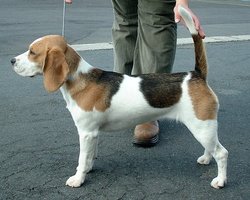Beagle
|
|
| Beagle | ||||||||||||||
|---|---|---|---|---|---|---|---|---|---|---|---|---|---|---|
| Alternative names | ||||||||||||||
| ||||||||||||||
| Country of origin | ||||||||||||||
| United Kingdom | ||||||||||||||
| Classification | ||||||||||||||
| ||||||||||||||
| Breed standards (external links) | ||||||||||||||
| FCI (http://www.google.com/search?q=cache:THL_ceL-FykJ:www.fci.be/uploaded_files/161gb2000_en.doc+site:www.fci.be+%22161+/+24.+07.+2000%22&hl=en&ie=UTF-8), AKC (http://www.akc.org/breeds/beagle/index.cfm), ANKC (http://www.ankc.aust.com/beagle.html) KC(UK) (http://www.the-kennel-club.org.uk/discoverdogs/hound/h770.htm), NZKC (http://www.nzkc.org.nz/br416.html), UKC (http://www.ukcdogs.com/breeds/scenthounds/beagle.std.shtml) |
A Beagle is a medium-sized dog breed and a member of the hound group, similar in appearance to a Foxhound but smaller with shorter legs, and with longer, softer ears. Beagles are scent hounds used primarily for hunting rabbits to larger hares.
| Contents |
Appearance
The Beagle has a somewhat domed skull; a medium-length, square-cut muzzle; large, hound-like hazel or brown eyes; long, low-set ears (big), turning towards the cheeks slightly and rounded at the tips; a medium-length, strong neck without folds in the skin; a short, slightly curved tail; an overall muscular body; and a medium-length, smooth, hard coat. They appear in a range of colors, not limited to the familiar tricolor (white with large black and light brown spots). Beagles that only have two colors are known as lemon beagles.
Breed Varieties
The American Kennel Club and the Canadian Kennel Club recognize two separate varieties of Beagle: the 13-inch for hounds less than 13 inches, and the 15-inch for those between 13 and 15 inches. The Kennel Club (UK) and FCI affiliated clubs recognize a single type, with a height of between 13 and 16 inches.
Temperament
The Beagle has a very good temper. Beagles are intelligent, but are stubborn and may be hard to train (due to their strong will). They are an especially loyal breed and are very friendly. They rarely show signs of aggression and are excellent with children. Beagles also get along with other dogs, provided that they have been socialized correctly.
They are playful and energetic dogs that enjoy long walks. Beagles have minds of their own and can get into trouble because of this. Beagles also don't like being left alone and sometimes howl, bark, or cry when they are left alone. Getting a companion dog may improve or prevent this problem.
Health
The Beagle's ears are long, which can prevent air from reaching the ear canals. Careless bathing can get water into their ears, potentially causing ear infections. Sometimes their eyelashes grow into the eye and irritate the eye; this might require surgery to remove the eyelashes. Obesity is a common health problem in Beagles; they need exercise and a controlled diet.
History
Beagles (or their ancestors) appear to have been used for hare hunting in England as early as the reign of Edward III, who had a pack of up to 120 hare hounds with him on the battlefield during the Hundred Years' War. The first mention of the beagle in English literature by name dates from 1475. The origin of the word "beagle" is uncertain, although it has been suggested that the word derives from the French begueule (meaning "open throat") or from an Old English, French, or Welsh term meaning "small."
Beagles were originally used for hunting, and still are in some places. Beagling has been referred to as "the poor person's foxhunting," as a Beagle pack (30-40 dogs) is followed on foot, not horseback. The usual quarry is the hare. Beagles are admired by some for the bloodcurdling "Beagle music" they emit when in full pursuit. Beagling, like foxhunting, is banned in England. Drag hunting is another Beagle sport.
Due to their trusting and gentle nature, beagles are the dog most often used in animal experiments.
Working Life
Beagles have superb noses and, despite their self-willed temperament, are sometimes used as sniffer dogs for drug detection. More often, though, they are the breed of choice of the United States Department of Agriculture to detect food items in luggage being transported into the U.S. The force is called the Beagle Brigade and these dogs wear a green jacket. Beagles were chosen because they are small and easy to care for, and because they are not as intimidating for people who are uncomfortable around dogs. They are also used for this purpose by the Ministry of Agriculture and Fisheries in New Zealand and by the Australian Quarantine and Inspection Service (for whom they wear maroon jackets).
Dog Pictures and Clipart
- Pictures of Dogs (http://classroomclipart.com/cgi-bin/kids/imageFolio.cgi?direct=Animals/Dogs)
- Dog Clipart (http://classroomclipart.com/cgi-bin/kids/imageFolio.cgi?direct=Clipart/Animals/Dog_Clipart)
Clipart and Animal Pictures
- Clipart (https://classroomclipart.com/image/category/clipart.htm)
- Animal Clipart (https://classroomclipart.com/image/category/animal-clipart.htm)
- Animal Animated Clipart (https://classroomclipart.com/clipart/Animations/Animals.htm)
- Pictures of Animals (https://classroomclipart.com/image/category/animal-photos.htm)
- Amphibian Clip Art, Pictures and Photogaphs (https://classroomclipart.com/image/category/amphibian-clipart.htm)
- Farm Animal Clip Art, Pictures and Photographs (https://classroomclipart.com/image/category/farm-animal-clipart.htm)
- Mammal Clip Art, Pictures and Photographs (https://classroomclipart.com/image/category/mammal-clipart.htm)
- Marine Animal Clip Art, Pictures and Photographs (https://classroomclipart.com/image/category/marine-life-clipart.htm)
- Reptile Clip Art, Pictures and Photographs (https://classroomclipart.com/image/category/reptile-clipart.htm)
- Spider Clip Art, Pictures and Photographs (https://classroomclipart.com/image/category/spider-clipart.htm)



